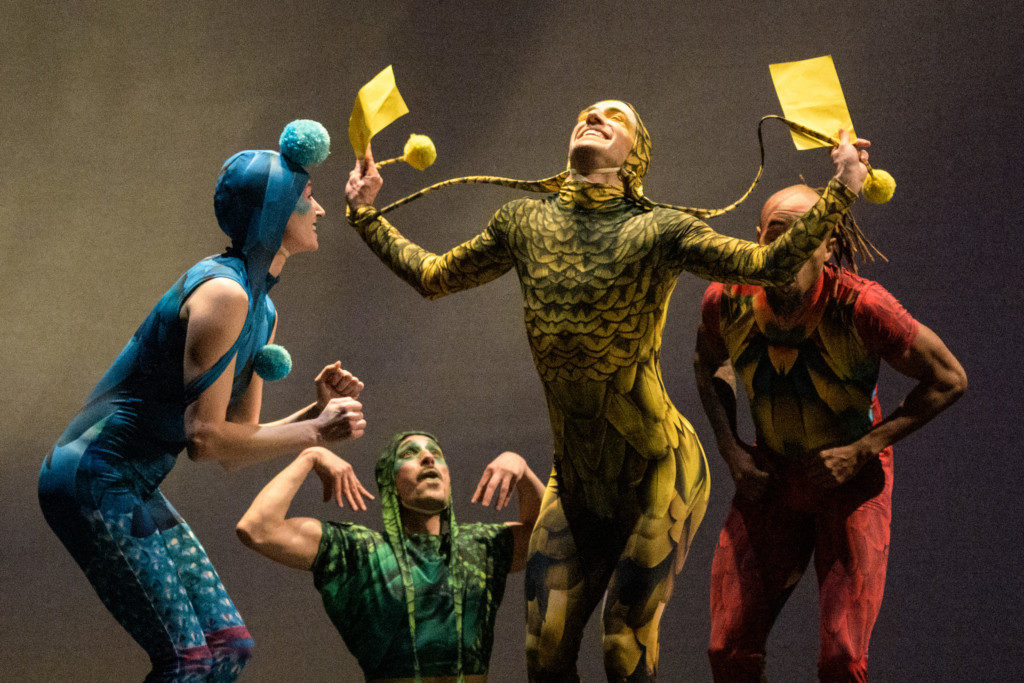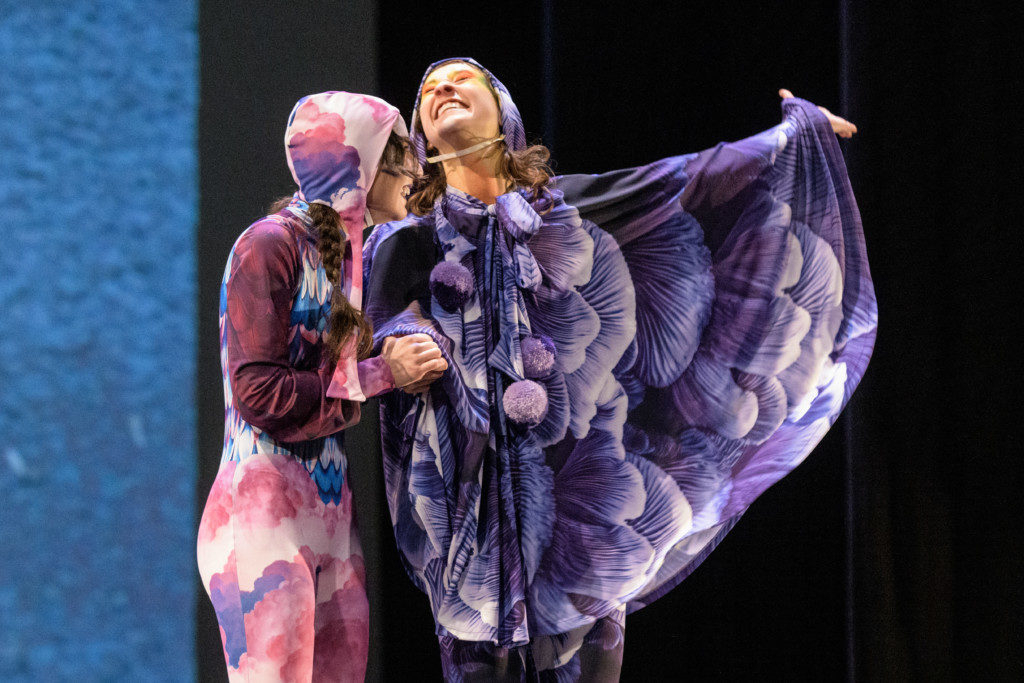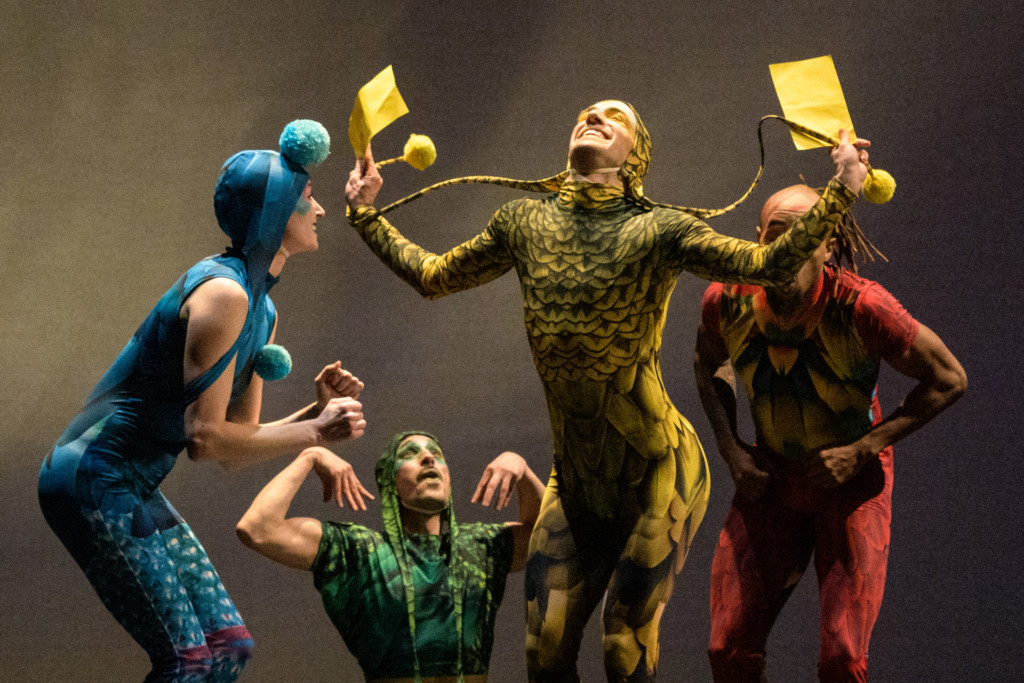In the hands of the collaborators for the recent Ririe-Woodbury Dance Company concert, the stories of the Red Fred Project were transformed into a vibrant, colorful, innocent, joyful, poignant and glistening landscape. For the project’s young authors and their curator Dallas Graham, the live creature and ethereal things concert was like an animated film made full in flesh and character.
The collaborators – Ririe-Woodbury, the Flying Bobcat Theatrical Laboratory and Red Fred Project — heightened the senses evoked in the stories created by their young authors, who have rare diseases and chronic illness and who are mentored by Graham. The young authors’ creative voices are naturally poetic, full of innocence and vivid imagination. On stage, the six dancers were transformed into the bird characters of the Jolly Troop, joined by Robert Scott Smith, the narrator, who asks the audience if you could tell the world story, what would it be. Smith and Alexandra Harbold from Flying Bobcast guided the theatrical contributions to the production.

The transformation is complete with the delightful costumes created by Jared Gold that accentuate dancers’ pitch-perfect character movement and the musical score by John Paul Hayward. The music draws the audience to the performance with an exquisitely tempered exuberance as this shimmering world of fantasy and innocence comes alive, occasionally punctuated by lyrics sung by Smith. Throughout the work, Hayward’s music signals perfect segues with frequent shifts in the rhythmic undercurrents. There are many timbres of sound that convey an ever-glistening dreamscape of adventure, taking on an occasionally exotic flavor.
Daniel Charon’s choreography, created in studio with many enhancements by the dancers, consolidates the imagery of the performers as birds in their movements with head, hands and arms. The dancers are so transported in their extended roles as actors that each character elicits fully the description on the pages of the Red Fred stories: Bashaun Williams as Red Fred, Yebel Gallegos as Dred Fred and Algernon, Melissa Rochelle Younker as Penny and Upper Twin, Megan McCarthy as Stilts and Under Twin, Breanne Saxton as Yvette and Cassidy Montez and Brian Nelson as Magnus.
The opening sequence merges the literary and dance worlds so effortlessly, when Smith appears on stage for the first and opens the book that suddenly transforms the performing space into the enchanting world as the entire flock of dancers enters. Even in the scenes between the generous, warm-hearted Red Fred and the mischievous troublemaker Dred Fred, the playful counterpoint suggests true camaraderie is never absent, especially in moments where dancers display acrobatic and athletic elements including lifts and cartwheels. The audience is invited at some points to be more than passive spectators, as the dancers urge the audience to stand and echo the moves on stage. Dance is perhaps the most egalitarian and most accessible of the performing arts. Every movement speaks to our nature and character, and we should never hesitate to express ourselves as such.

The live creature and ethereal things. Ririe-Woodbury Dance Company, Flying Bobcat Theatrical Laboratory, Red Fred Project. Photo Credit: Stuart Ruckman.
The literary dimensions are omnipresent: distinct movements in each dancer, the brief messages spoken by the narrator and the sharing of stories from the Red Fred Project. One story, Running on the Wind, by Meghan Waldron and Graham, is read in a voiceover narration – in Spanish with projected subtitles in English. One line elicits some of the heartiest laughter of the evening: “Sure I’m small, but so are poison dart frogs.” The closing sequence is simple but so perfect in its punctuation, with the dancers on stage under a fluttering storm of sheets of colored paper.
This artistic collaboration succeeded for its unrestrained joy, a feeling shared among every participant. Indeed, it is a piece like the live creature and ethereal things that reminds us how creative work for family and children is as significant and valuable and artistic achievement as those that convey the most profound elements of dramatic emotion. Of all his music, the French composer Maurice Ravel considered Ma mère l’Oye, his Mother Goose five-piece suite, among his most important. Ravel was charmed by the two children of a young Polish couple in Paris who often hosted evenings with French artists.

The live creature and ethereal things. Ririe-Woodbury Dance Company, Flying Bobcat Theatrical Laboratory, Red Fred Project. Photo Credit: Stuart Ruckman.
The composer, who never had any children, was so moved that he wrote a four-hand piano suite based on the Mother Goose stories for them and later turned it into a full orchestral suite. Ravel did not believe anyone would remember him after he died – a shocking statement to contemporary audiences given that virtually every work he wrote has become part of the standard repertoire. He worried that people would remember him only as a bitter lonely man. The children he met had inspired him to rediscover, as he described in his letters, the poetry of childhood.
Indeed, we are grateful to the young authors whom Graham has introduced us to, as part of the world of Red Fred and the Jolly Troop. Their gifts assured a concert with an impressive standard of poetic excellence.

